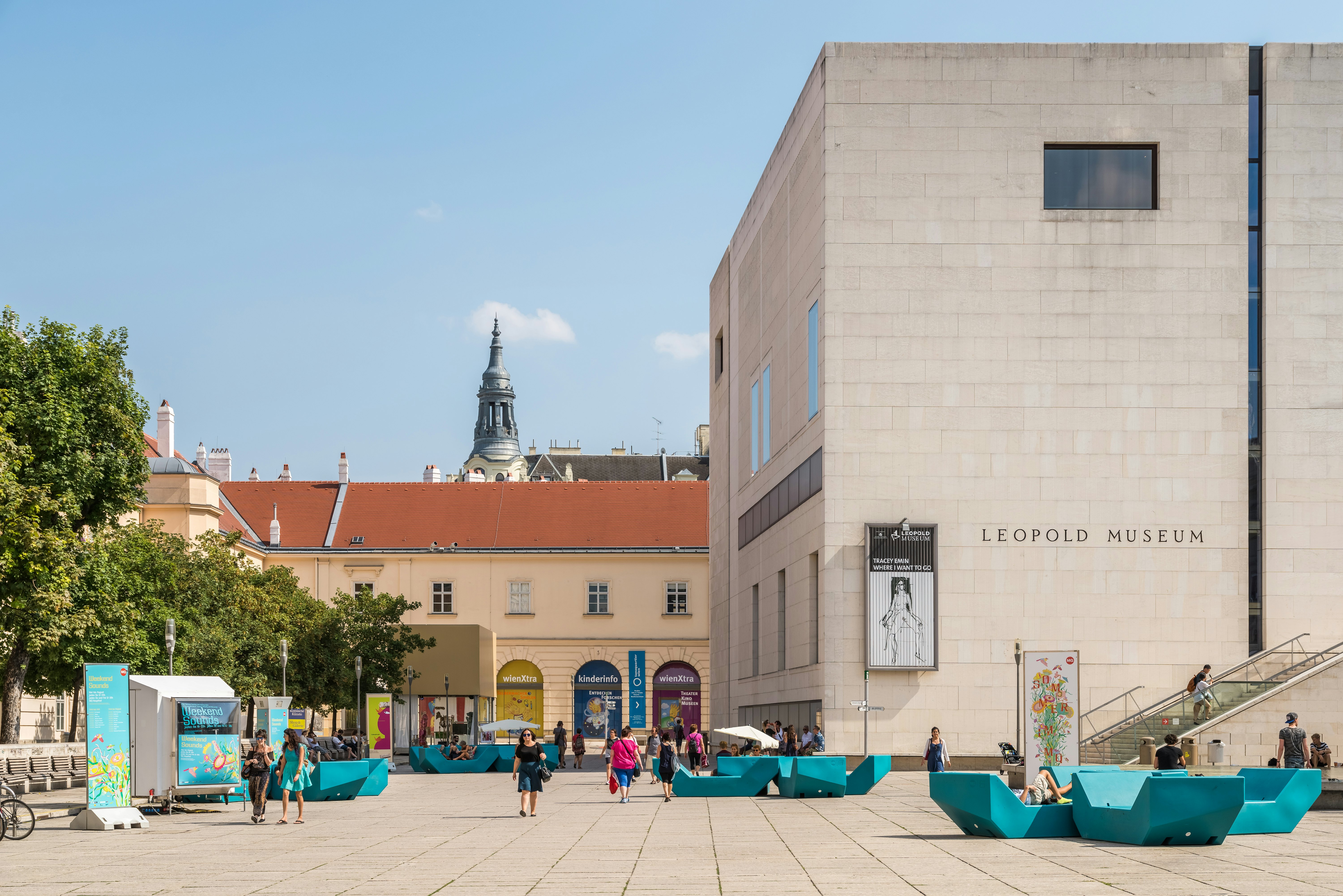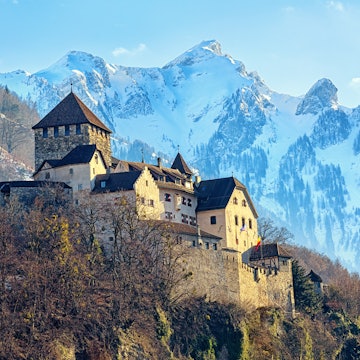

Gustav Klimt’s “The Kiss” at Schloss Belevedere. Mariangela Cruz/Shutterstock
Austria's capital punches well above its size as a center of culture. Savvy visitors know that they can waltz through galleries for weeks on end and barely scratch the (gilded, painted or carved) surface of Vienna's art scene.
Even after dozens of visits, it’s possible to stumble across new collections that intrigue and excite. Had your fill of old masters amassed by emperors and displayed in ornate palaces? Cleanse your viewing palate with topics as obscure as coffee, snow globes and chimney sweeps. After you are fully dazzled by Gustav Klimt’s golden wonders at Schloss Belvedere, delve into the darker side at museums examining crime, film noir and funerals. Find contemporary art installed in buildings that are works of art in themselves, or stagger past display cases containing a vast number of objects crafted by nature (fossils) or hand (Egyptian mummies to glittering jewels).
While the city's scores of institutions cater to every conceivable niche, it is best to start with these eight classic museums in Vienna.
1. Albertina
Best for graphic art and grandeur
Habsburg royals once put up their guests in the swanky imperial state apartments that are now open to visitors of the Albertina. Started in 1776 by Duke Albert of Saxe-Teschen, the collection brings together more than a million drawings and prints from the late Gothic era to the present.
Michelangelo, Rubens, Rembrandt and Goya paintings are shown in rotating exhibitions. The impressionists and postimpressionists — Degas, Cézanne, Toulouse-Lautrec, Gauguin – also have their moment to shine. Austrian art takes the spotlight with masterpieces by Klimt, Oskar Kokoschka and Albin Egger-Lienz. And everyone is keen to get a glimpse of Albrecht Dürer’s iconic Young Hare (1502), Egon Schiele’s erotic Female Couple (1915) and Andy Warhol’s pop portrait of Mao Tse-Tung (1972).
Planning tip: A 10-minute walk south on Karlsplatz leads to the Albertina Modern, an offshoot that opened in 2020 and exhibits post-1945 works charting the most recent eight decades of Austrian art.

2. Schloss Belvedere
Best for Klimt and baroque excess
Johann Lukas von Hildebrandt designed this baroque summer palace on an epic scale for Prince Eugene of Savoy in the early 18th century. Stand at the Oberes Belvedere and you can’t help but swoon as you trail a finger across Vienna’s skyline, perfectly framed by tiered landscaped gardens where sculpted mythical beasts cavort and cascades gently splash.
Yet if you’re an art enthusiast, you’re probably here for one reason alone: Klimt, whose sensually dreamlike, gold-kissed, mosaic-patterned works hold viewers captive. Schloss Belvedere contains the biggest collection of Klimt's art, so forgo a leisurely breakfast and arrive as the palace opens bang on 9am for a crowd-free glimpse of his masterwork, The Kiss, as well as sensations like Judith and the Head of Holofernes.
And Klimt is just the start. You would be wise to linger over other late-19th- to early-20th-century Austrian works – by Schiele, Kokoschka and more – in sumptuous rooms replete with marble, frescoes and stucco.
3. Fälschermuseum
Best for forgeries
It would take a razor-sharp professional eye (and possibly a magnifying glass) to spot that the paintings on display in this tiny, privately run museum aren’t quite the real deal. Just opposite the rainbow-bright Hundertwasserhaus, Vienna’s wonderfully quirky Fälschermuseum (Museum of Art Fakes) presents a top-notch collection of works that look original but are in fact very convincing reproductions.
Copies of Schiele, Klimt, Raphael, Rembrandt, Turner, Monet, Picasso and Chagall by some of the world’s most skilled forgers will easily both deceive and beguile. Besides giving background on the who, how, when and what, the museum spills the beans about the copycats that managed to fool experts.


4. Kunsthistorisches Museum
Best for old masters
If you see only one museum in Vienna, make it the outstanding Kunsthistorisches Museum (Art History Museum), lodged in a domed neoclassical building that rises from the Ringstrasse. Brace yourself for a breathtaking, epoch-spanning romp through art and artifacts, reflecting the extraordinary legacy (not to mention voracious collecting) of the Habsburgs, who ruled the Austro-Hungarian empire for centuries.
You might begin with a chronological spin through Greek, Roman, Egyptian and Near Eastern antiquities, zooming in on funerary objects, sculptures and writing development from about 3500 BCE, with fine examples of sarcophagi, mummies, mosaics and gold treasure. Kunstkammer Wien is an extraordinary chamber of curiosity; luxurious gemstones, coral and ostrich eggs transformed into brilliant artworks will delight your inner magpie.
The Kunsthistorisches’ true highlight is the Gemäldegalerie (Picture Gallery), where the walls all but groan with masterpieces by Titian, Tintoretto, Rubens, Vermeer, Van Eyck, Rembrandt, Raphael, Caravaggio, Velázquez and many more. The collection is especially strong in canvases by Pieter Bruegel the Elder, including his unmissable 1563 Tower of Babel.
Planning tip: This museum is too big for just one bite, so pick up a floor plan and audio guide to devise your itinerary (and count on a return visit, if you have time). Revive museum-weary eyes in the palatial cupola cafe. For fewer crowds, come during the Thursday evening session, from 6pm to 9pm.

5. Naturhistorisches Museum
Best for dinosaurs
No, you’re not imagining things – you are seeing double. Vienna’s neoclassical, cupola-topped Naturhistorisches Museum is the spitting image of the Kunsthistorisches across the plaza and was also commissioned by Emperor Franz Joseph I in the late 19th century.
The lavishly stuccoed, frescoed halls follow 4 billion years of natural history, cantering through minerals, fossils, dinosaur bones, insects and animals from an inventory of 30 million fascinating objects. Keep an eye out for exceptional finds, like the teeny 25,000-year-old Venus of Willendorf, a buxom figurine believed to be a fertility symbol, and the mind-blowing 1100-piece meteorite collection. Audio guides lend plenty of insight.
Planning tip: Kids in tow? Check the dates of the popular Nacht im Museum (Night in the Museum), which includes a flashlight tour, films in the planetarium and a night spent next to the dinosaurs (bring your sleeping bag).

6. Haus der Musik
Best for music
Mozart, Haydn, Beethoven, Schubert, Strauss (both father and the Waltz King son), Brahms, Mahler…you can’t walk a block in Vienna without rubbing shoulders with the ghosts of great composers. Their symphonies, operas and concertos still reverberate in the city’s opulent concert halls.
Tuning in to the city’s remarkable musical legacy, the fun, hands-on Haus der Musik presents an engaging, kid-friendly journey through sound. Visitors can mimic conducting the Vienna Philharmonic, madly waving a baton to the Radetzky March, or compose their own waltz by rolling dice. The first floor is devoted to the founder of the Vienna Philharmonic, Otto Nicolai, who lived in this house from 1841 to 1847.
Planning tip: For something a bit more polished than bashing out your own melodies on the piano staircase that links the museum’s four floors, attend one of the concerts in the glassed-in courtyard.

7. Leopold Museum
Best for modern art
Designed by baroque starchitect Johann Fischer von Erlach, these revamped imperial stables are quite something. Today, the site has become the MuseumsQuartier, a dynamic cultural hub with galleries showcasing modern, postmodern and contemporary art; courtyard cafes, bars and restaurants; and shops and performance spaces. A single ticket gets you access to everything.
You could devote an entire day to exploring the complex, but if you have time for just one museum, make it the Leopold, a giant white limestone cube bathed in natural light. It’s a striking backdrop for the largest collection of works by Schiele: 41 paintings and 188 drawings and graphic works. Don’t miss the ghostly Self-Seer II (Death and Man), the mournful Mother with Two Children and Cardinal and Nun (Caress).
Other well-represented Austrian artists include Egger-Lienz, with his raw depictions of pastoral life; the expressionist Kokoschka; and secessionists Josef Hoffmann, Otto Wagner and Klimt (particularly the allegorical stunner Death and Life).

8. KunstHausWien
Best for architecture
As you wander the streets of Vienna’s 3rd district, Landstrasse, the dazzling facade of the KunstHausWien will suddenly bowl you over. This curvaceous black-and-white-tiled, mirror-dotted marvel bears the inimitable imprint of one of Austria’s most outlandish artists and architects: Friedensreich Hundertwasser (1928–2000). A rebel with an environmental cause, Hundertwasser believed that the straight line was “godless” and that nature should run riot – hence the wonky walls and floors, bulging ceramic elements and trees that sprout from the grass roof.
The gallery presents a high-caliber roster of temporary exhibitions, often with an ecological theme that chimes with Hundertwasser’s revolutionary green politics. It’s also an ode to the artist, with a permanent collection of his playful art that pushes the boundaries of convention and reveals his dislike for urban conformity. Tracing the evolution of the artist’s style, the exhibition skips from watercolors and portraits to travel-inspired abstract works and tapestries, covering themes from philosophy to ecology and architecture.
















